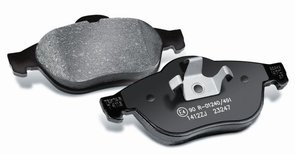Brake pad
The task of vehicle brakes is to decelerate the vehicle safely and comfortably, bringing it to a standstill if necessary. This is done by means of converting the kinetic energy due to friction between the brake...
Function
The task of vehicle brakes is to decelerate the vehicle safely and comfortably, bringing it to a standstill if necessary. This is done by means of converting the kinetic energy due to friction between the brake pads and the brake discs or drums into thermal energy. In this way the speed of the vehicle is reduced as required by the driver.
 The brake pads (also known as friction lining) have a very important role to play here. If that the friction linings are to achieve optimum braking results under varying operating conditions, a complex material manufactured from a range of very different components (composite material) is the order of the day. This material must not fail under any circumstances.
The brake pads (also known as friction lining) have a very important role to play here. If that the friction linings are to achieve optimum braking results under varying operating conditions, a complex material manufactured from a range of very different components (composite material) is the order of the day. This material must not fail under any circumstances.
With high levels of safety in mind, brake pads must combine a
- constant friction value (friction coefficient) with
- high mechanical strength and
- temperature resistance.
New brake pads require a specific "running-in period" before they are able to achieve their full braking power. During this phase, the surface of the pad adapts to the surfaces of the discs/drums. It is only after this period that an optimum connection is established between the friction pairs (brake pad/disc, brake pad/drum) so that maximum deceleration can be achieved when braking.
Structure of a disc brake pad
Brake pads have a sandwich-type construction.
The brake pad plate
The brake pad plate forms the basis of the brake pad. It must hold the brake pad in the brake calliper and pass the temperature to the neighbouring components.
Damping
Most brake pads feature damping on the reverse side in the form of springs, foils, sheet steel or paint/varnish, designed to reduce the noise generated during braking.
Intermediate layer and friction material
An intermediate layer and the actual friction material are pressed onto the brake pad plate between the brake pad and the brake disc. An adhesive layer just a few µm thick is applied between the brake pad plate and the underlayer. This ensures a secure connection between the plate and the intermediate layer/friction material. Expanded metal, Sinterrauhgrund, a "combed plate" or pin-type anchors can be used as alternative to the intermediate layer or as an additional measure to increase the mechanical strength of the plate connection.
Depreciation
Brakes that function reliably are vital for safe travel in motor vehicles. They should therefore be checked regularly to ensure that they are in perfect working order and that their component parts are not suffering from wear. A well-maintained brake that is in perfect working order which a driver feels can be relied upon is the most important step on the way to feeling safe when driving.
Safety
The brakes are one of the most important safety systems of a vehicle. Unbeknown to the driver, they are applied and released hundreds if not thousands of times a day. The driver usually only brakes consciously if braking does not follow the usual procedure.
Therefore, it is important that brake pads are able to meet the demands of everyday use and always perform as expected – regardless of changes in climatic, topographical or application conditions. As well as having to deliver optimum performance in everyday situations, brake pads also have to be capable of producing the best possible response in extreme situations in particular (during emergency braking, for example). Therefore, the brake pad must provide the driver with an assurance of optimum performance at all times so that the best possible braking results can be achieved.

















